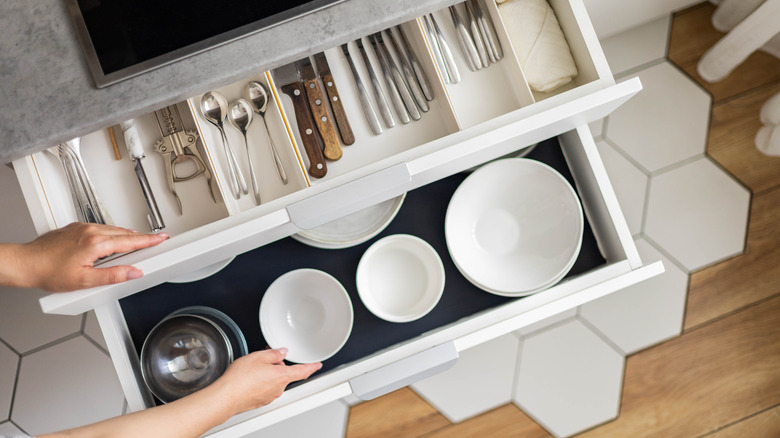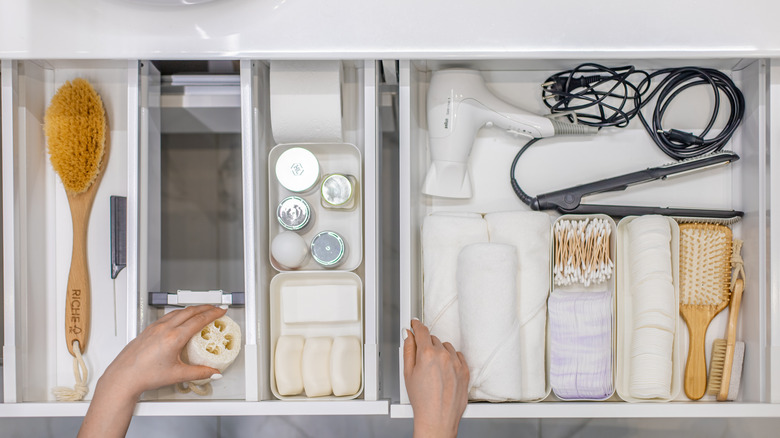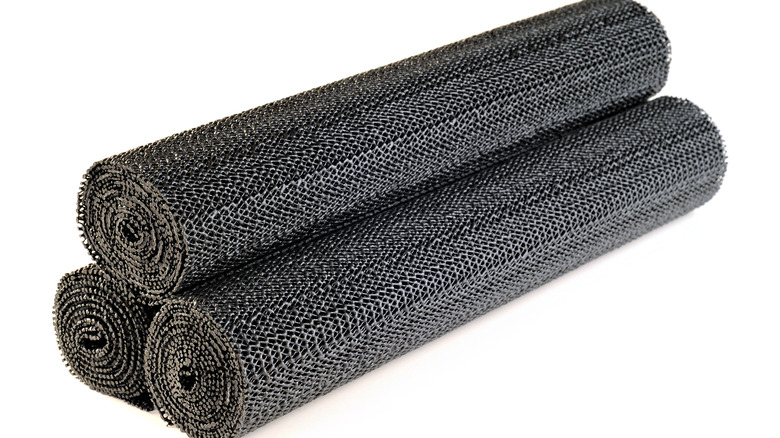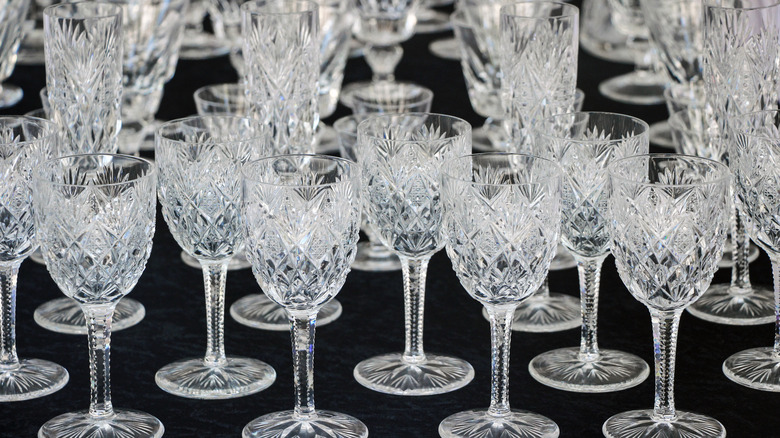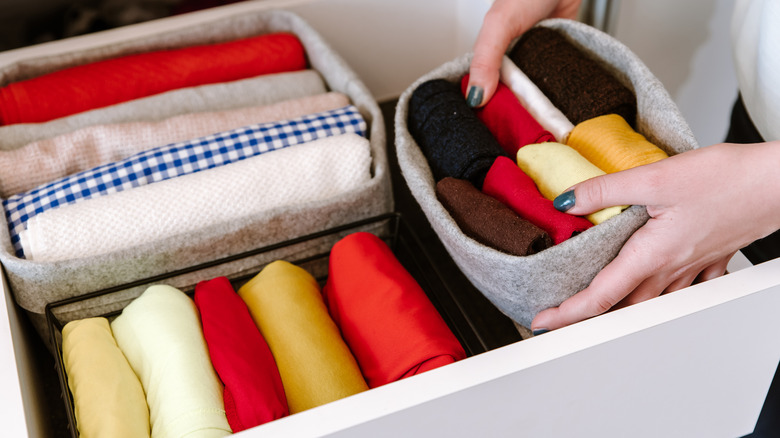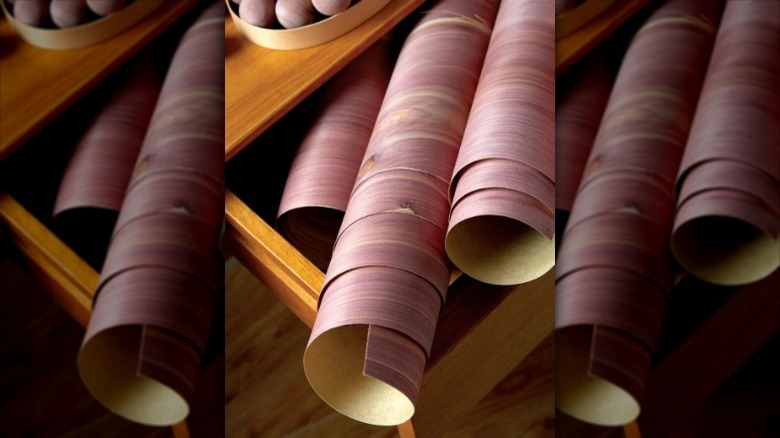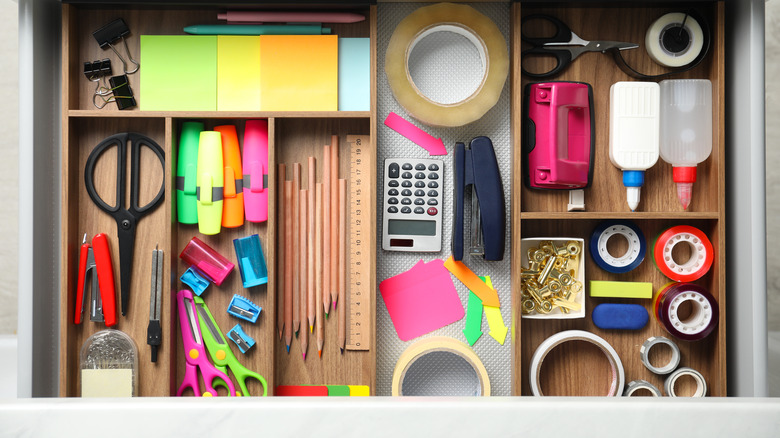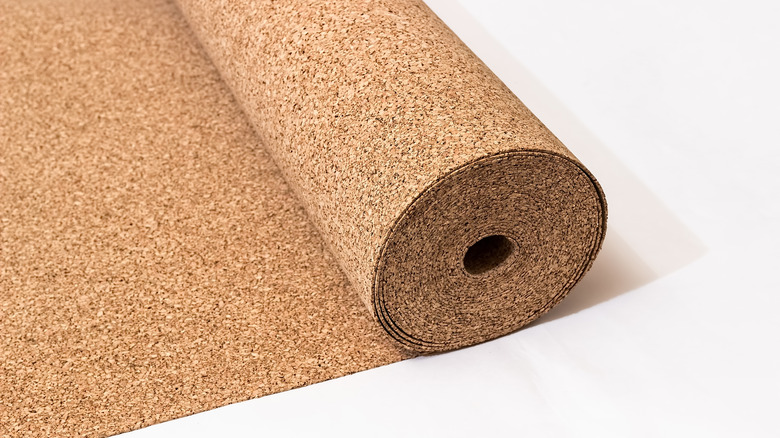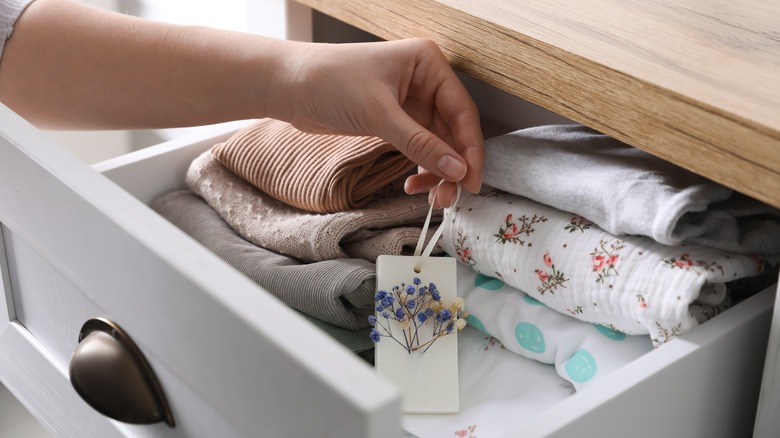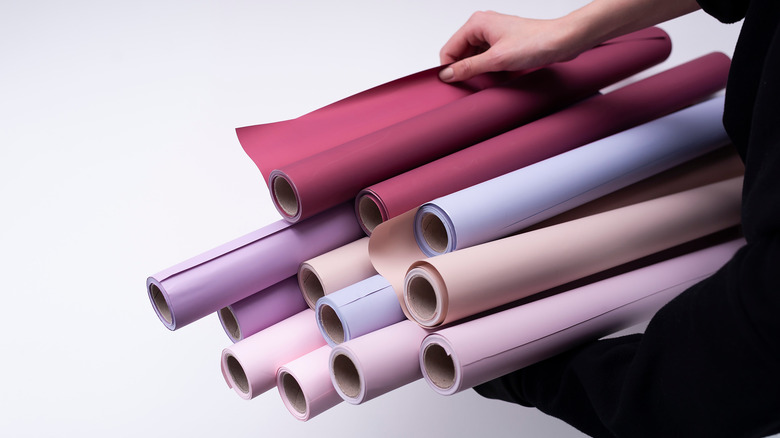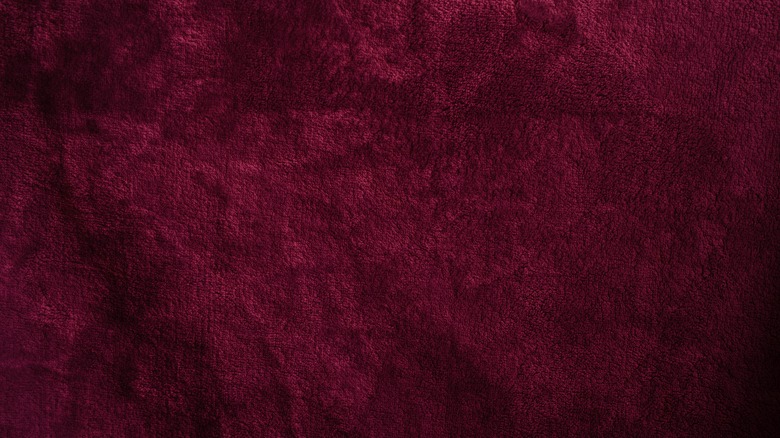The Best Drawer Liners For Upgraded Organization
We may receive a commission on purchases made from links.
Many of your possessions live in the drawers throughout your home, including those in your kitchen, bathroom, home office, bedroom, and living room. To protect the stored objects and enhance your home's overall organization, it's a good idea to line your drawers with the best materials. Depending on your drawers' locations and functions, you might look for washable, non-slip, padded, or moisture-absorbent materials. Additionally, you may choose between adhesive and non-adhesive options.
Manufacturers offer an array of commercially available products for lining drawers. These include flexible polyvinyl chloride (PVC), cedar wood, and natural cork. Additionally, DIYers use various materials and methods to make homemade liners. They use wallpaper, gift-wrap paper, and fabrics like velvet, wool felt, and upholstery materials. In fact, you can choose to purchase pre-made materials or go the DIY route for many applications. Whether you're organizing a dresser drawer in your bedroom, a make-up drawer in the bathroom, or a utensil drawer in the kitchen, there's a suitable lining material for each scenario. Here are some of the best liners for each project.
An adhesive drawer liner stays in place
There's nothing more annoying than bunched-up liner. For a neat and tidy drawer, an adhesive liner produces a smooth finish. Start by removing everything from the drawer and vacuuming any loose dust or debris. Then, wipe the drawer with a damp cloth, using a mild detergent dissolved in water. Dry the bottom of the drawer with a dry cloth and allow it to air dry. Once the drawer bottom is thoroughly dry, you can install the adhesive liner. Be sure to leave the backing attached to the material during the first steps.
First, measure your drawer to determine its length and width. Use the grid lines on the paper backing to cut a piece of liner to the correct size. With the backing still attached, place the liner in the bottom of the drawer and apply painter's tape to secure one end of the liner to the drawer. Then, starting at the other end, slowly peel the backing and press the adhesive liner to the bottom of the drawer. If the liner is crooked, lift and reposition it immediately. Once the liner is straight, remove the tape from the other end and continue peeling the backing until the entire drawer bottom is covered. Use a putty knife or credit card to iron out any bubbles in the liner. Gorilla Grip Peel and Stick Adhesive Removable Liner is a great option to start with.
Non-adhesive, PVC liners are easy to install and remove
Non-adhesive lining material made from polyvinyl chloride (PVC) is a convenient option for lining drawers. The flexible, rubbery material comes on a roll, and cutting the liner to fit your drawers is easy. Although this type of liner does not feature glue or adhesive, it does stay in place due to its gripping capacity and tacky feeling. For extra holding power, you can place a dab of mounting putty in each corner of the drawer. When it's time to clean or replace the liner, you can easily remove it without leaving residue from an adhesive substance.
Start the installation process by emptying and thoroughly cleaning your drawer. Then, measure and cut the liner material to size. Simply place it in the drawer and smooth it out on the bottom surface. A non-adhesive PVC liner protects your drawers from spills and stains. When things get messy, removing and washing the liner is easy. This material is durable, and the liner can be used over and over again. Gorilla Grip Drawer and Shelf Liner is an optimal, non-adhesive material for lining drawers.
Padded drawer liners protect glassware and fragile objects
Some of your stored possessions may be especially fragile. You might have collected or inherited antique and vintage glassware, dishes, and crystal objects. If you keep any of these items in drawers, it's important to provide padded liners to protect them from damage. Luckily, you can make your own lining for such collectibles. First, measure and cut a piece of cardboard to fit your drawer. Then, use a carving knife to slice blocks of florist foam into sheets approximately 1-2 inches thick. Use enough sheets of foam to cover the cardboard, and attach them with glue. Place your objects on the foam, and press them down to make depressions that take on the sizes and shapes of the objects. To finish the liner, you'll want to remove the items and wrap the foam-covered cardboard in fabric. Use duct tape to secure the outer edges of the material to the back of the cardboard. Then, simply place the finished liner in the bottom of your drawer.
If you don't want to make your own padded drawer liners, you can use commercially manufactured options. They will protect your glassware, dishes, and heirlooms from chipping, and they'll keep the items from rolling around inside the drawer. Drymate Premium Luxury Shelf & Drawer Liner is a non-adhesive drawer liner that provides plenty of cushioning for fragile objects.
Scented drawer liners make your clothes smell amazing
When you're getting dressed, retrieving clean, fresh clothes from neatly organized dresser drawers feels good. If the clothes smell amazing due to scented drawer liners, the feeling is even better. Drawer liners protect the wooden surfaces of dresser drawers from dust and stains. On top of that, the scented types add a bit of aromatherapy to your closet or bedroom. Starts at 60 explains that you can prepare your own scented lining paper by steeping a tea bag for three minutes in a spray bottle full of warm water. Then, remove the tea bag and add two drops of oil-of-clove along with 2-3 drops of your favorite essential oil. Spritz the mixture onto your liner paper until damp, then hang the piece to dry. When it's dry, place the scented paper liner in your dresser drawer.
According to Supernaturale, you can skip the tea-bag step if you'd prefer. Instead, simply mix approximately ½ teaspoon of essential oil with a little more than 1 ½ fluid ounces of water. Spray the mixture onto the paper and lay it on a drying rack or hang it from a clothesline. When it's dry, the paper will retain the luxurious scent. If you prefer to use a commercially prepared, scented drawer lining material, the Elodie Essentials Scented Drawer Liners are an excellent option.
Cedar-wood liners protect the clothing in your drawers
For centuries, people have used cedar closets and chests to store a variety of textile items, including clothing, blankets, and bed linens. The primary reason for cedar's popularity is that it naturally repels bugs. Moth larvae, silverfish, termites, cockroaches, and crickets all feast on fabrics. Wool and cashmere are most at risk, but insects aren't picky. However, these bugs are driven away by the smell of a natural oil that infuses the fibers of cedar wood. It's this quality that makes a cedar-lined drawer a safe place for storing your clothing.
For humans (not insects), cedar emits a clean, pleasant scent. We associate it with nature and fresh, woodsy locales. Additionally, cedar acts as a natural dehumidifying agent. In humid environments, cedar extracts moisture from the air, thereby minimizing the risk of mold and mildew growth. To gain the advantages of cedar-lined storage, you can purchase rolls of Red Top Cedar Veneer Drawer Liner. Simply cut the cedar veneer material to the correct size and place it in the bottom of the dresser drawers where you keep your clothing.
Non-slip drawer liners keep items from sliding around
Once you've cleaned, sorted, and organized the items that you keep in a drawer, it can be maddening when they slide around and become a jumbled mess. Drawer organizing trays are a convenient accessory to hold flatware and utensils in the kitchen or small office items in a desk drawer. But these trays simply slide around inside the drawer if they don't have enough traction, which can break the aesthetic of a perfectly organized drawer.
That's where non-slip drawer liners come in. They are made of a soft, flexible, plastic-mesh material with a tacky surface. This ensures the trays stay put, but if you need some more help, you can try adding museum putty to the bottom corners of the organizers. The liners are non-adhesive, but they stay in place inside your drawers. Smart Design Classic Grip Shelf Liner is a popular, non-slip, drawer-lining material to start with.
Cork is an ideal, natural material for lining drawers
Many people prefer using natural products in their homes whenever possible. Cork is a natural and sustainable material that is harvested from the bark of cork oak trees in Europe, the Mediterranean region, and northwest Africa. Although it naturally absorbs water, cork is not damaged by water. Additionally, it repels mold and mildew, making it an ideal lining material for drawers where moisture might be a problem. In kitchen drawers, cork liners eliminate the water spots and discoloration from putting away utensils when they're not quite dry.
The drawers in kitchens, craft rooms, and workshops frequently serve as repositories for potentially damp items, and the solution might be to line them with a flexible, self-adhesive cork liner. Cork has a semi-soft texture that cushions the objects placed on it, keeping any goo or dampness far away from the drawers underneath. Con-Tact Brand Cork Roll offers easy installation with a self-adhesive backing that keeps the liner securely in position. Simply unroll the liner, cut it to size, and carefully peel off the paper backing to adhere it to the bottom of your drawer.
Line your drawers with fabric that enhances your decor
Fabric is available in a plethora of colors, designs, and textures. For the creative DIY decorator, fabric drawer liners may add an elegant and personal touch to a bedroom makeover. To make your own, start with upholstery fabric with a degree of thickness and body. Measure your dresser drawers and cut the material 1-to-3 inches larger than the bottoms of the drawers.
Next, you'll need to make the fabric as stiff as cardboard so you can use it to line the drawer. Both Aleene's Fabric Stiffener and Draping Liquid and Mod Podge Plaid Stiffy Fabric Stiffener yield good results for this purpose. Use a large bowl or bucket and follow the package directions to soak the fabric in the stiffening liquid. Then, lay the fabric flat and allow it to air dry. When it's completely dry, iron the material on a steam iron setting to obtain a smooth finish. Now, the fabric will feel like thin cardboard, and it's time to trim it to the exact dimensions of your drawer. Use scissors or a rotary cutter to create straight edges. Finally, you can simply place the stiff fabric in the bottom of your drawers. If desired, you can put small pieces of double-sided tape in the corners to prevent slipping.
For a budget-friendly option, try lining your drawers with paper
In locations where moisture is not a problem, paper is a useful material for lining drawers. Creative DIY decorators line drawers with gift-wrapping paper, wallpaper, craft paper, scrapbook paper, old maps, and book pages. When using wallpaper or wrapping paper from a roll, the first step is to lay out and cut the paper a bit larger than the bottom of the drawer. Then, lay the paper inside the drawer, and press along the edges to create creases in the paper. Next, remove the paper and cut along the creases with scissors or a craft knife. These steps will ensure that the piece of paper is the exact size of the drawer bottom. Finally, you can place the paper in the drawer and secure the corners with glue dots or small rolls of tape. For a more permanent installation, you can spray the drawer bottom with adhesive before inserting the paper.
Alternatively, you might line a drawer with paper that comes in smaller pieces. For example, it might take several book pages or pieces of scrapbook paper to line a drawer. This type of project requires a gluing and sealing medium such as Mod Podge Sealer and Finish. Apply the medium to your drawer and to the back of the paper. Apply each piece and smooth it with a brayer or the edge of a credit card. When the paper is thoroughly dry, you can finish the project with a spray-on acrylic sealer.
Felt or velvet drawer liners protect your jewelry and valuable heirlooms
You probably have a few drawers in your home where you store jewelry and fragile heirlooms that you want to protect from damage. You may want to line these drawers with felt or velvet, providing a soft, cushioned surface for your prized possessions. In addition to protecting the special objects, felt and velvet look elegant and exude a luxurious vibe in your home. These materials offer not only protective qualities, but also dampen sound. Consequently, you won't hear metal objects rattling around as you open and close your drawers.
Both felt and velvet absorb moisture, and this quality helps to protect metals from tarnishing. For best results, use 100% wool felt or high-quality velvet for lining a drawer. First, measure your drawer and cut a piece of poster board to size. Next, cut a piece of velvet or felt to the correct size and attach it to the poster board with spray adhesive. Then, you can easily pop the liner into the drawer and secure the corners with mounting putty or glue dots. If you prefer purchasing manufactured rolls of velvet or felt drawer liner, check out Mesheshe Soft Velvet Drawer Liner and Self Adhesive Velvet Flock Contact Paper by Wall Decor.
